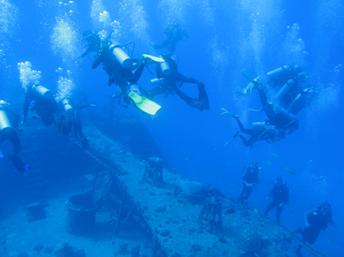The students went to 100 feet on the dive — that’s about 30 meters. From my introduction to the Day 5 blog, 10 meters of water weighs about the same as the entire atmosphere. Thus at 30 meters below the surface, the students were experiencing pressures four times that experienced at the surface. Such pressures can cause problems for divers unless they are careful. “Dive profiles” are designed to keep divers safe. If divers ascend too fast from too deep, for example, they increase their risk of getting decompression sickness, or “the bends.” The sickness occurs when gases absorbed in the body at high pressure form small bubbles in the blood when the pressure drops.
When we were on a field program in the South Pacific, divers had not only to watch their dive profiles — they were forbidden to fly the day after a dive. This is because of the possibility that the aircraft might lose pressure at altitude. Also, aircraft at altitude aren’t pressured to surface pressure but to around 6000 feet.
In contrast, cabin pressure in the space shuttle is equivalent to sea level, according to Robert Mellette of the Yale New Haven Teachers Institute.
Day 8 – 18 October 2007
The two groups have rejoined and spent the day on four dives. The deepest one was to about 100 ft. They must follow strict control of their dive profiles to be able to complete all the dives. Several of them broke their profiles and had to sit out the last dives. The ODC students were also still recovering from the climb up Mauna Kea and two were too tired to make the dives.
The first dive is on a wreck, and the students did some archaeological surveys, using the techniques they learned in the classroom and practiced from shore the day before with Dr. Hans Van Tilburg.
The day ended with a talk by Astronaut and Shuttle Mission Commander Dom Gorie, who will take the ODC banner with him on his space shuttle mission, scheduled to launch 14 February 2008.
Madison – 13
SNI participant
We did a dive at the Yard Oiler wreck. I went to about 70 feet. There were huge turtles on the deck of the ship. We also saw a few Humuhumunukunukuapua’a, Hawaii’s state fish (a triggerfish). The second dive was on a reef. We saw a white tip and I did a swim-through. We also saw a sleeping sea turtle. Our third dive was on a flipped barge. We did photography with Dr. Gleason. There was a current. After our dives, we had a lecture given by Commander Dom Gorie, an astronaut. He told us about NASA and his previous and upcoming trips into space.

Mack – 15
Operation: Deep Climb participant
The first dive was a wreck dive. The wreck was in about 100ft of water and it was called the YO. After the first dive most of the ODC was tired so we stayed on the boat and took a nap. After the second dive we went back to port for a quick lunch and then it was right back onto the boat for the last two dives. The third dive was a wreck where we had to measure its length and width. On this dive most people broke there profile so most of us did not dive the fourth dive.
David – 15
Operation: Deep Climb participant
The water here was so much clearer than in the Tampa Bay. We had fun.

Anna – 16
Operation: Deep Climb participant
Today we went diving with Island Divers. The ODC kids and I had to rent gear. For the first dive I was buddies with Santannah, and we dove on a wreck, I saw sea turtles. I was very tired and wasn’t up to the second dive. Then we docked for lunch and went back out for two more dives.
I did the first dive of the afternoon, but I broke my dive profile, so did many other people. Only about five people were able to do the last dive. It didn’t bother me that I missed it because I just enjoyed watching a sunset from a boat in Hawaii. What more could you ask for?
Tonight we had pizza while Commander Gorie (Andrew’s Dad) told us about his career as an astronaut.
